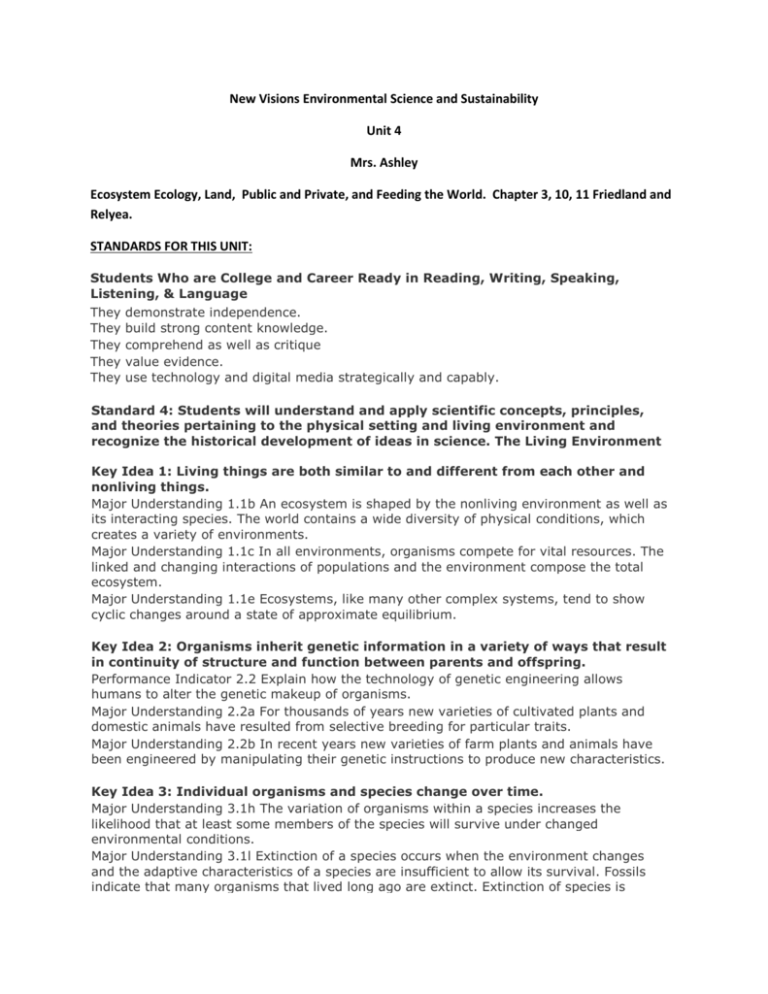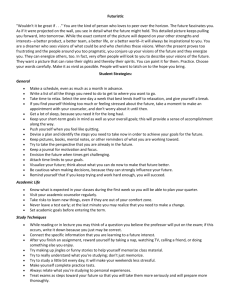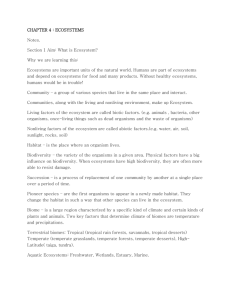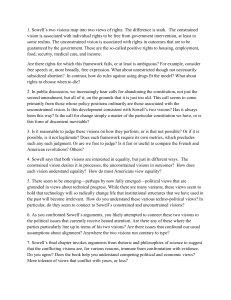New Visions Environmental Science and Sustainability Unit 4 Mrs
advertisement

New Visions Environmental Science and Sustainability Unit 4 Mrs. Ashley Ecosystem Ecology, Land, Public and Private, and Feeding the World. Chapter 3, 10, 11 Friedland and Relyea. STANDARDS FOR THIS UNIT: Students Who are College and Career Ready in Reading, Writing, Speaking, Listening, & Language 12 Capacities of the Literate Individual They They They They They demonstrate independence. build strong content knowledge. comprehend as well as critique value evidence. use technology and digital media strategically and capably. Standard 4: Students will understand and apply scientific concepts, principles, and theories pertaining to the physical setting and living environment and recognize the historical development of ideas in science. The Living Environment Key Idea 1: Living things are both similar to and different from each other and nonliving things. Major Understanding 1.1b An ecosystem is shaped by the nonliving environment as well as its interacting species. The world contains a wide diversity of physical conditions, which creates a variety of environments. Major Understanding 1.1c In all environments, organisms compete for vital resources. The linked and changing interactions of populations and the environment compose the total ecosystem. Major Understanding 1.1e Ecosystems, like many other complex systems, tend to show cyclic changes around a state of approximate equilibrium. Key Idea 2: Organisms inherit genetic information in a variety of ways that result in continuity of structure and function between parents and offspring. Performance Indicator 2.2 Explain how the technology of genetic engineering allows humans to alter the genetic makeup of organisms. Major Understanding 2.2a For thousands of years new varieties of cultivated plants and domestic animals have resulted from selective breeding for particular traits. Major Understanding 2.2b In recent years new varieties of farm plants and animals have been engineered by manipulating their genetic instructions to produce new characteristics. Key Idea 3: Individual organisms and species change over time. Major Understanding 3.1h The variation of organisms within a species increases the likelihood that at least some members of the species will survive under changed environmental conditions. Major Understanding 3.1l Extinction of a species occurs when the environment changes and the adaptive characteristics of a species are insufficient to allow its survival. Fossils indicate that many organisms that lived long ago are extinct. Extinction of species is common; most of the species that have lived on Earth no longer exist. Key Idea 5: Organisms maintain a dynamic equilibrium that sustains life. Major Understanding 5.2b Viruses, bacteria, fungi, and other parasites may infect plants and animals and interfere with normal life functions. Major Understanding 5.2j Biological research generates knowledge used to design ways of diagnosing, preventing, treating, controlling, or curing diseases of plants and animals. Key Idea 6: Plants and animals depend on each other and their physical environment. Performance Indicator 6.1 Explain factors that limit growth of individuals and populations. Major Understanding 6.1a Energy flows through ecosystems in one direction, typically from the Sun, through photosynthetic organisms including green plants and algae, to herbivores to carnivores and decomposers. Major Understanding 6.1d The number of organisms any habitat can support (carrying capacity) is limited by the available energy, water, oxygen, and minerals, and by the ability of ecosystems to recycle the residue of dead organisms through the activities of bacteria and fungi. Major Understanding 6.1e In any particular environment, the growth and survival of organisms depend on the physical conditions including light intensity, temperature range, mineral availability, soil/rock type, and relative acidity (pH). Performance Indicator 6.2 Explain the importance of preserving diversity of species and habitats. Major Understanding 6.3a The interrelationships and interdependencies of organisms affect the development of stable ecosystems. Key Idea 7: Human decisions and activities have had a profound impact on the physical and living environment. Performance Indicator 7.1 Describe the range of interrelationships of humans with the living and nonliving environment. Major Understanding 7.1a The Earth has finite resources; increasing human consumption of resources places stress on the natural processes that renew some resources and deplete those resources that cannot be renewed. Major Understanding 7.1b Natural ecosystems provide an array of basic processes that affect humans. Those processes include but are not limited to: maintenance of the quality of the atmosphere, generation of soils, control of the water cycle, removal of wastes, energy flow, and recycling of nutrients. Humans are changing many of these basic processes and the changes may be detrimental. Major Understanding 7.1c Human beings are part of the Earth's ecosystems. Human activities can, deliberately or inadvertently, alter the equilibrium in ecosystems. Humans modify ecosystems as a result of population growth, consumption, and technology. Human destruction of habitats through direct harvesting, pollution, atmospheric changes, and other factors is threatening current global stability, and if not addressed, ecosystems may be irreversibly affected. Performance Indicator 7.2 Explain the impact of technological development and growth in the human population on the living and nonliving environment. Major Understanding 7.2a Human activities that degrade ecosystems result in a loss of diversity of the living and nonliving environment. For example, the influence of humans on other organisms occurs through land use and pollution. Land use decreases the space and resources available to other species, and pollution changes the chemical composition of air, soil, and water. Major Understanding 7.2b When humans alter ecosystems either by adding or removing specific organisms, serious consequences may result. For example, planting large expanses of one crop reduces the biodiversity of the area. Performance Indicator 7.3 Explain how individual choices and societal actions can contribute to improving the environment. Major Understanding 7.3a Societies must decide on proposals which involve the introduction of new technologies. Individuals need to make decisions which will assess risks, costs, benefits, and trade-offs. Key Idea 2: Many of the phenomena that we observe on Earth involve interactions among components of air, water, and land. Major Understanding 2.1s Weathering is the physical and chemical breakdown of rocks at or near Earth's surface. Soils are the result of weathering and biological activity over long periods of time. Major Understanding 2.1t Natural agents of erosion, generally driven by gravity, remove, transport, and deposit weathered rock particles. Each agent of erosion produces distinctive changes in the material that it transports and creates characteristic surface features and landscapes. In certain erosion situations, loss of property, personal injury, and loss of life can be reduced by effective emergency preparedness. Major Understanding 2.1u The natural agents of erosion include: - Streams (running water): Gradient, discharge, and channel shape influence a stream's velocity and the erosion and deposition of sediments. Sediments transported by streams tend to become rounded as a result of abrasion. Stream features include V-shaped valleys, deltas, flood plains, and meanders. A watershed is the area drained by a stream and its tributaries. Glaciers (moving ice): Glacial erosional processes include the formation of U-shaped valleys, parallel scratches, and grooves in bedrock. Glacial features include moraines, drumlins, kettle lakes, finger lakes, and outwash plains. - Wave Action: Erosion and deposition cause changes in shoreline features, including beaches, sandbars, and barrier islands. Wave action rounds sediments as a result of abrasion. Waves approaching a shoreline move sand parallel to the shore within the zone of breaking waves. - Wind: Erosion of sediments by wind is most common in arid climates and along shorelines. Windgenerated features include dunes and sand-blasted bedrock. - Mass Movement: Earth materials move down slope under the influence of gravity. Major Understanding 2.1w Sediments of inorganic and organic origin often accumulate in depositional environments. Sedimentary rocks form when sediments are compacted and/or cemented after burial or as the result of chemical precipitation from seawater. Key Idea 3: Matter is made up of particles whose properties determine the observable characteristics of matter and its reactivity. Major Understanding 3.1a Minerals have physical properties determined by their chemical composition and crystal structure. - Minerals can be identified by well-defined physical and chemical properties, such as cleavage, fracture, color, density, hardness, streak, luster, crystal shape, and reaction with acid. - Chemical composition and physical properties determine how minerals are used by humans. NY: Math, Science and Technology NY: Commencement: Earth Standard 7 Interdisciplinary STANDARD 7—Interdisciplinary Problem Solving Students will apply the knowledge and thinking skills of mathematics, science, and technology to address real-life problems and make informed decisions. Connections Key Idea 1: The knowledge and skills of mathematics, science, and technology are used together to make informed decisions and solve problems, especially those relating to issues of science/technology/society, consumer decision making, design, and inquiry into phenomena. Students consider environmental and social implications of various solutions to an environmental Earth resources problem Topics: Ecosystem Ecology Earth Systems Feeding the World Public Land Classification Logging, Urban Sprawl, and forestry practices Industrial Farming and alternatives GMOs Use of Pesticides Sustainable agriculture Aquaculture and global fisheries Green revolution Ecological relationships Labs and Projects for Unit 4, Chapter 3, 10, and 11: Biosphere Lab (New Visions Grade) Net Primary Productivity of Rye grass (A.P. Grade) Quadrat study and Shannon Weiner Diversity Index (New Visions Grade) Mapping of Wildflower Woods and Tree Identification (New Visions Grade) View movie King Corn (New Visions Grade) Continue work on Winograsky Column] (New Visions Grade) Continue work on Soil lab (Soil lab due January , New Visions Grade) The Habitable Planet on Agriculture (A.P. Grade) Student PowerPoint on Biogeochemical cycles Biology of the soil lab Envirothon: Prepare for Wildlife: Tree Identification; Information on Silvaculture, reading a soil map; soil classification; measuring slope (New Visions Grade) Field Trips and Speakers (New Visions Grade) Guest Speaker on GIS, Mapping and conserving open space Work with Educators at Teatown teaching lesson Field trip to Cabbage Hill on hydroponics and aquaculture (December Field trip to long standing exclosure site Field trip to the Bronx Zoo behind the scenes Alternative activities: Global Feast, view movie Fast Food Nation, view movie Food, Inc., Soil Salinization lab, View video: How food shapes our cities by Carolyn Steel Assignments and Projects: Chapter 3: Ecology 1. Watch one of the video lectures on ecology on the Teacher Webpage from the University of California at Berkeley. Take notes, outline, or write definitions from watching the video you selected. (Due Tuesday, November 27) Videos are from an undergraduate lecture course on Wildlife Ecology and last about 45 minutes. (A.P. Grade) 2. Read Chapter 3 in the textbook on Ecosystem Ecology (Due Monday, November 19) Do note taking using the PQRST method of note taking. Notes are due Monday, November 26. (A.P. Grade) PQRST METHOD: The weakness with rote learning is that it implies a passive reading or listening style. Educators such as John Dewey have argued that students need to learn critical thinking - questioning and weighing up evidence as they learn. This can be done during lectures or when reading books.. One method used to focus on key information when studying from books is the PQRST method. This method prioritizes the information in a way that relates directly to how they will be asked to use that information in an exam. PQRST is an acronym for Preview, Question, Read, Summary, Test. 1. Preview: The student looks at the topic to be learned by glancing over the major headings or the points in the syllabus. 2. Question: The student formulates questions to be answered following a thorough examination of the topic(s). 3. Read: The student reads through the related material, focusing on the information that best relates to the questions formulated earlier. 4. Summary: The student summarizes the topic, bringing his or her own understanding into the process. This may include written notes, spider diagrams, flow diagrams, labeled diagrams, mnemonics, or even voice recordings. 5. Test: The student answers the questions drafted earlier, avoiding adding any questions that might distract or change the subject. There are a variety of studies from different colleges nation-wide that show peer-communication can help increase better study habits tremendously. One study shows that an average of 73% score increase was recorded by those who were enrolled in the classes surveyed.[ 3. View Mrs. Ashley's PowerPoint on chapter 3 and write down any questions you have about the chapter. (due Tuesday, November 27) (New Visions Grade) 4. Do Workbook pages: 50-73; 116 Due Monday, December 3 (A.P. Grade) 4. You will be presenting one of the cycles in nature to help your fellow students learn about biogeochemical cycles. Please do this assignment as a PowerPoint. As each student presents, you will be completing a mind map on the specific cycle being presented. The cycles are: carbon, phosphorous, nitrogen, sulfur, hydrologic, potassium, calcium and magnesium. Your presentation should include the following about your cycle: an illustration of the cycle, the reservoirs, source and sinks for the cycle along with the amount of the substance contained in the reservoirs and sinks, the time for flux and human impact on the cycle including rate of flux. Please see resources on the chapter resources. (Due Thursday, December 6, we will be presenting all week, a few at a time) (New Visions Grade) Biogeochemical mind map due after all presentations (A.P. grade) 5. Do one of the following to help you learn the concepts in chapter 3: (Due Thursday, November 29) (A.P. Grade) A. Vocabulary chapter 3 B. Go to the following website on Rabbits and Wolves and answer the following questions: http://www.shodor.org/interactivate/activities/RabbitsAndWolves/ 1. What would happen if there were lots more bunnies than there are were wolves? Would the bunnies take over and live forever? 2. What would happen if there were lots more wolves than there are bunnies? Would the wolves live forever? 3. How do the rabbits and wolves live in balance in this game? (Try and manipulate the game to find out the answers to questions 1-2 C. Do worksheet on eating at a lower trophic level D. Read the article on Ecosystem services and write a one page summary of the important points of the article 6. Test, Friday, December 7 on the following topics: (New Visions and A.P. Grade) Net Primary Productivity and Gross Primary Productivity; Biogeochemical Cycles; Trophic Levels; Food chains; Food webs; producers, consumers, detritivores, decomposers; Photosynthesis and Respiration; Biomass; Standing Crop; Ecological efficiency; trophic pyramid; Ecosystem disturbance, resilience and resistance; instrumental and intrinsic value; intermediate disturbance hypothesis; ecosystem services. 7. Continue to read one article per week and summarize for Senior Exit Project (due on Thursdays, New Visions grade) Assignments and Projects Chapter 10 Land Use, Public and Private 1. Read chapter 10 and take notes using outlining, mind mapping, or PQRST method. Due Friday, November 30 (A.P. grade) 2. Do Workbook pages: 140-146; 148; 223-225 (A.P. Grade, due Tuesday, December 4) 3. Watch Mrs. Riche's PowerPoint on chapter 10 and write down any questions you have on the chapter (New Visions Grade, due Thursday, December 6) 4. Complete the mind map on different categories of public lands in the United States as a class jigsaw. (Due Friday, December 7; New Visions grade) 5. Do one of the following: (A.P Grade, Due Monday, December 10) A. Vocabulary Chapter 10 B. Answer questions on chapter 10 C. Attend a Land Use Planning meeting in your community and write a paragraph of your experience there. (You have until January 8th to complete this portion of the assignment) 6. Test on chapter 10, December 10 (A.P. grade and New Visions Grade) Assignments for chapter 11 Chapter 11 Feeding the World 1. Read Chapter 11 and watch Mrs. Ashley's PowerPoint for the chapter. Write down any questions you have as you read the chapter. Due Tuesday, December 11, (New Visions Grade) 2. Do workbook pages 122-138; 149-153 (A.P. Grade; due Thursday, December 13) 3. Choose one of the following for chapter learning: (due Saturday, December 15 A.P. grade) A. Do vocabulary for chapter 11 B. Grocery Store Project: Go to the supermarket and choose 3 major food groups. Choose 4 foods from each food group and research labels, information to find the distance (in miles) that the food needed to travel from harvesting to your table. Calculate the amount of gasoline required to bring the food to your table if the food was moved by tractor trailer. You will need to research the miles per gallon that an average tractor trailer uses. Assume that each of the foods came separately to your store. C. View one of the on-line videos and write a summary and write your reaction to the video and how you would take action based on what you learned: (due December 15 New Visions grade) What's wrong with what we eat at http://www.ted.com/talks/lang/eng/mark_bittman_on_what_s_wrong_with_what_we_eat.html or Why we are saving billions of seeds at http://www.ted.com/talks/lang/eng/jonathan_drori_why_we_re_storing_billions_of_seeds.html or How Food Shapes our cities at http://www.ted.com/talks/lang/eng/carolyn_steel_how_food_shapes_our_cities.html 4. Test on chapter 11 due December 18 (A.P. and New Visions Grade)









